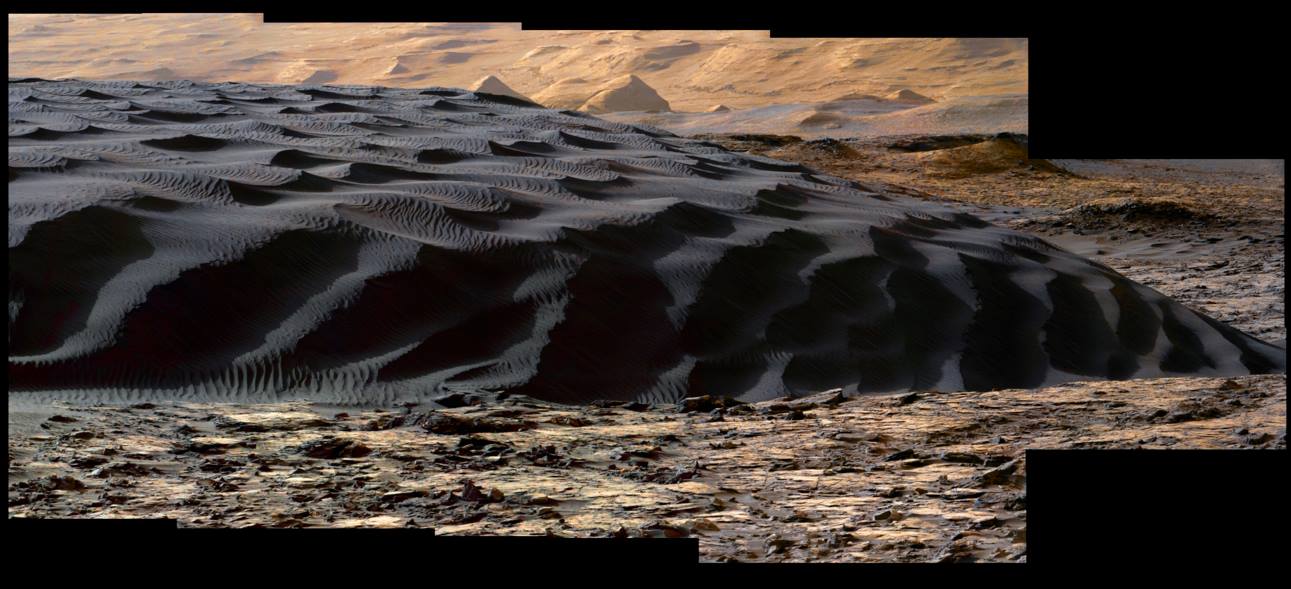It looks like you're using an Ad Blocker.
Please white-list or disable AboveTopSecret.com in your ad-blocking tool.
Thank you.
Some features of ATS will be disabled while you continue to use an ad-blocker.
share:
This pic from a site I haven't visited in quite a while. APOD

If you follow the link and click on the image displayed, it will open a panoramic (I hope that's the correct word) image of much better quality. I kind of wish this one was in color so we could see the contrast more clearly.

If you follow the link and click on the image displayed, it will open a panoramic (I hope that's the correct word) image of much better quality. I kind of wish this one was in color so we could see the contrast more clearly.
Explanation: What is that dark sand dune doing on Mars? NASA's robotic rover Curiosity has been studying it to find out, making this the first-ever up-close investigation of an active sand dune on another world. Named Namib Dune, the dark sand mound stands about 4 meters tall and, along with the other Bagnold Dunes, is located on the northwestern flank of Mount Sharp. The featured image was taken last month and horizontally compressed here for comprehensibility. Wind is causing the dune to advance about one meter a year across the light bedrock underneath, and wind-blown sand is visible on the left. Part of the Curiosity rover itself is visible on the lower right. Just in the past few days, Curiosity scooped up some of the dark sand for a detailed analysis. After further exploration of the Bagnold Dunes, Curiosity is scheduled to continue its trek up the 5-kilometer tall Mount Sharp, the central peak in the large crater where the car-sized rover landed.
A Dark Sand Dune on Mars
Looks like tailings dump from a mining operation to me. The flutes in the dune look to me like they something to do the with type of material it is but then that's just a guess.
Looks like tailings dump from a mining operation to me. The flutes in the dune look to me like they something to do the with type of material it is but then that's just a guess.
Looks like someone has written the letter "H" in the dust on the Rover if you look.
The dark sand on Mars is almost everywhere, even under the reddish coating that covers most of the planet.
All you have to do is dig.
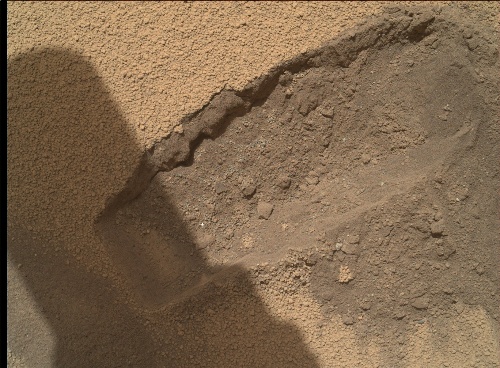
All you have to do is dig.

originally posted by: kumiho
One of the worst Photoshop images ive seen
I was thinking same thing when I opened OP. Something doesn't sit right with that image. .
Also in the background, seems like someone playing with lighting, contrast, brightening etc. . Left side is light and such, then there is random "gloomy" region in the same space (sky/background).
It doesn't seem natural. I understend they may edit these photos prior to public release, to make them look better.
In such a process, the public is unaware of the editing taking place unless we have photo masters to chime in.
Always had the assumption, as nasa edits photos and releases them, they may also cover or completely remove landscapes or apparent anomalies.
Also, they always hide the background of the galaxy, stars etc. .
Anyone notice,
There are no tire tracks visible
The electrical connections visible have quick disconnects on them on the rover
So, how did it get there and who would "quickly" work on it if one of the electrical or electro-hydraulic units failed?
Interesting...
There are no tire tracks visible
The electrical connections visible have quick disconnects on them on the rover
So, how did it get there and who would "quickly" work on it if one of the electrical or electro-hydraulic units failed?
Interesting...
originally posted by: NightFlight
Anyone notice,
There are no tire tracks visible
The electrical connections visible have quick disconnects on them on the rover
So, how did it get there and who would "quickly" work on it if one of the electrical or electro-hydraulic units failed?
Interesting...
Depending on from which direction it approached, the tracks may not be that evident. Having said that, there are some tracks visible in portions of the fine sand between the stretches of bedrock on the left side of the OP's image.
From the image linked by the OP:
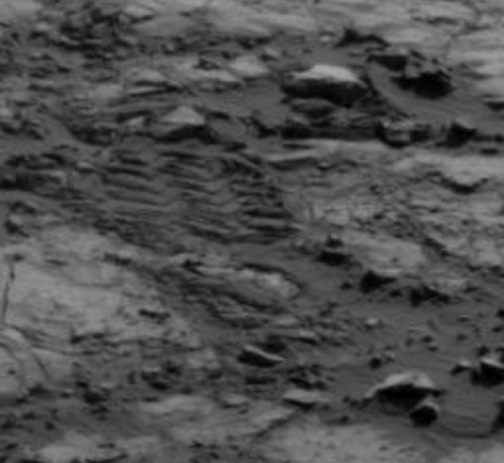
And from the color version linked by Gortex, we can see tracks on the left:

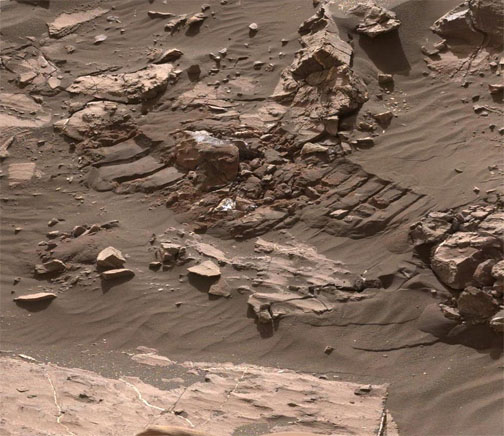
...and on the right (being a 360 degree panorama, the left and right edges of the image represent the same general area)
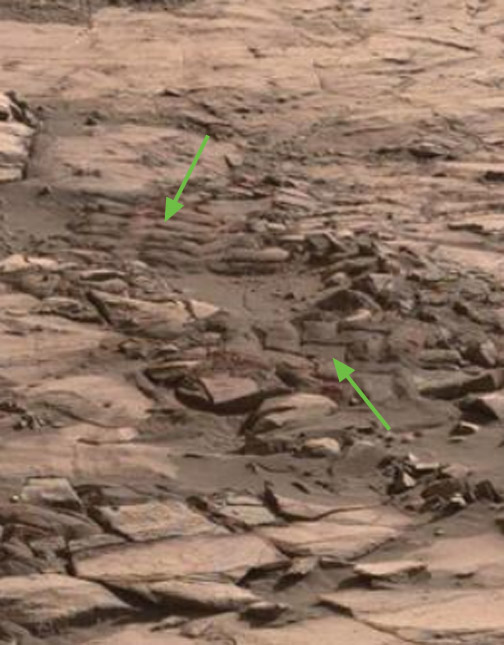
As for the electrical connections, perhaps they wanted the rover to have easy disconnects (yet secure ones) during the testing phase of the rover. I'm guessing they most likely tested the rover under different circumstances, and being able to disconnect some of the instruments was probably useful.
Once testing was complete, and the rover checked out, I doubt they wanted to fiddle with the connections any further by change the connection method.
edit on 1/25/2016 by Soylent Green Is People because: (no reason given)
originally posted by: wildespace
The dark sand on Mars is almost everywhere, even under the reddish coating that covers most of the planet.
All you have to do is dig.
....so who's been digging?
...drew a bunch of 'chalk lines' on rocks in the fore ground, too.
interesting to say the least....
originally posted by: wildespace
...All you have to do is dig.
originally posted by: frayed1
....so who's been digging?
...drew a bunch of 'chalk lines' on rocks in the fore ground, too.
interesting to say the least....
Hmmm...
By the looks of the shadow, I'd say it was this robotic guy -- "H.E.L.P.eR":

edit on 1/25/2016 by Soylent Green Is People because: (no reason given)
Guys, do you really have to come into every single thread like this and claim that the picture is fake? Just because you don't understand how it was
taken or why it looks the way it does, doesn't mean it's been faked or photoshopped! Jeez! *gets his pants in a twist*
originally posted by: frayed1
originally posted by: wildespace
The dark sand on Mars is almost everywhere, even under the reddish coating that covers most of the planet.
All you have to do is dig.
....so who's been digging?
...drew a bunch of 'chalk lines' on rocks in the fore ground, too.
interesting to say the least....
The rover Curiosity has been digging, using a scoop on the end of its robotic arm (which also includes the camera that took that image).

The "chalk lines" are gypsum veins, "drawn" by nature. If anything, they are the proof that liquid water existed on Mars.
edit on 26-1-2016 by wildespace because: (no reason given)
originally posted by: Elementalist
originally posted by: kumiho
One of the worst Photoshop images ive seen
I was thinking same thing when I opened OP. Something doesn't sit right with that image. .
Also in the background, seems like someone playing with lighting, contrast, brightening etc. . Left side is light and such, then there is random "gloomy" region in the same space (sky/background).
It doesn't seem natural. I understend they may edit these photos prior to public release, to make them look better.
In such a process, the public is unaware of the editing taking place unless we have photo masters to chime in.
Always had the assumption, as nasa edits photos and releases them, they may also cover or completely remove landscapes or apparent anomalies.
Also, they always hide the background of the galaxy, stars etc. .
This image is a mosaic of several b&w photos taken by Curiosity's Navcam. The individual images have varying exposure levels, which is why the end result is a bit patchy. The bright area of the sky is where the Sun is.
Navcam mosaics and panoramas have always been tricky to assemble due to large field of view and great variation in exposure.
edit on 26-1-2016
by wildespace because: (no reason given)
originally posted by: wildespace
originally posted by: Elementalist
originally posted by: kumiho
One of the worst Photoshop images ive seen
I was thinking same thing when I opened OP. Something doesn't sit right with that image. .
Also in the background, seems like someone playing with lighting, contrast, brightening etc. . Left side is light and such, then there is random "gloomy" region in the same space (sky/background).
It doesn't seem natural. I understend they may edit these photos prior to public release, to make them look better.
In such a process, the public is unaware of the editing taking place unless we have photo masters to chime in.
Always had the assumption, as nasa edits photos and releases them, they may also cover or completely remove landscapes or apparent anomalies.
Also, they always hide the background of the galaxy, stars etc. .
This image is a mosaic of several b&w photos taken by Curiosity's Navcam. The individual images have varying exposure levels, which is why the end result is a bit patchy. The bright area of the sky is where the Sun is.
Navcam mosaics and panoramas have always been tricky to assemble due to large field of view and great variation in exposure.
Umm.. no its not. The sun is not in the background. . It's behind the camera, look at the shadows of the robot. Shadows pointing AWAY from camera lens.
So that doesn't really explain the blotches in the sky in the background of the rover, that looks edited. .
edit on 29-1-2016 by Elementalist
because: (no reason given)
originally posted by: Elementalist
originally posted by: wildespace
originally posted by: Elementalist
originally posted by: kumiho
One of the worst Photoshop images ive seen
I was thinking same thing when I opened OP. Something doesn't sit right with that image. .
Also in the background, seems like someone playing with lighting, contrast, brightening etc. . Left side is light and such, then there is random "gloomy" region in the same space (sky/background).
It doesn't seem natural. I understend they may edit these photos prior to public release, to make them look better.
In such a process, the public is unaware of the editing taking place unless we have photo masters to chime in.
Always had the assumption, as nasa edits photos and releases them, they may also cover or completely remove landscapes or apparent anomalies.
Also, they always hide the background of the galaxy, stars etc. .
This image is a mosaic of several b&w photos taken by Curiosity's Navcam. The individual images have varying exposure levels, which is why the end result is a bit patchy. The bright area of the sky is where the Sun is.
Navcam mosaics and panoramas have always been tricky to assemble due to large field of view and great variation in exposure.
Umm.. no its not. The sun is not in the background. . It's behind the camera, look at the shadows of the robot. Shadows pointing AWAY from camera lens.
So that doesn't really explain the blotches in the sky in the background of the rover, that looks edited. .
The shadows are deceiving because it is a cylindrical-perspective panorama. That ultra-wide panorama image covers about 230 to 240 degrees of area. The camera captured stuff in front of the rover, to the sides of the rover, and even partially behind the rover -- all in the same image.
Therefore, the shadows from the sun will be pointing in various directions.
To help explain this further, here is a full 360-dgeree panorama mosaic of the same area from he MastCam (the OP's mosaic image is from the NavCam). This is borrowed from Gortex' post above (thanks Gortex):
photojournal.jpl.nasa.gov...

In this full 360-degree color panorama, the front, sides, and even the back of the rover all appear in the same picture-mosaic. The left side of the picture is the same part of Mars as the right side of the picture. Imagine joining the two ends of that picture in a loop, with the location of the rover being in the middle of that loop. If you consider this, then it becomes evident that the shadows will be pointing in several various directions. Granted, the B&W NavCam mosaic doesn't cover the full 360 degrees, but it covers enough of a panoramic sweep to have this same "different shadow angle" effect.
The color MastCam image and the B&W NavCam images were taken at different times, so the apparent location of the Sun has moved, but in the Color MastCam mosaic, the Sun is generally behind Namib Dune, while in the NavCam mosaic, the Sun is about 1/4 way in from the left edge.
The information for the OP's image found in This Link tells us that the OP's image covers an area from the West (on the left edge) to the East-Southest (on the right edge). So that means we can see the west, the north, the east, and some of the way toward the Southeast in that one image. No wonder the shadows are in different directions.
Approximate cardinal directions annotated by me:

Also, consider this:
That white finned thing in the middle of the color image is the rover RTG (power unit). That RTG is in the rear of the rover, so the center of that image is generally looking towards the rear of the rover. So that means (being a 360-degree image) that the far left side and far right side of the image is what is in front of the rover (in the direction 180 degrees from the rear view). Like I said, the OP's image is not quite a 360 degree panorama, but the same effect still somewhat applies.
edit on 1/29/2016 by Soylent Green Is People because: (no reason given)
new topics
-
Cats Used as Live Bait to Train Ferocious Pitbulls in Illegal NYC Dogfighting
Social Issues and Civil Unrest: 1 hours ago -
The Good News According to Jesus - Episode 1
Religion, Faith, And Theology: 3 hours ago -
HORRIBLE !! Russian Soldier Drinking Own Urine To Survive In Battle
World War Three: 5 hours ago -
Bobiverse
Fantasy & Science Fiction: 8 hours ago -
Florida man's trip overseas ends in shock over $143,000 T-Mobile phone bill
Social Issues and Civil Unrest: 8 hours ago -
Former Labour minister Frank Field dies aged 81
People: 10 hours ago
top topics
-
President BIDEN Vows to Make Americans Pay More Federal Taxes in 2025 - Political Suicide.
2024 Elections: 17 hours ago, 19 flags -
Florida man's trip overseas ends in shock over $143,000 T-Mobile phone bill
Social Issues and Civil Unrest: 8 hours ago, 8 flags -
SETI chief says US has no evidence for alien technology. 'And we never have'
Aliens and UFOs: 12 hours ago, 7 flags -
Former Labour minister Frank Field dies aged 81
People: 10 hours ago, 4 flags -
Bobiverse
Fantasy & Science Fiction: 8 hours ago, 3 flags -
Ode to Artemis
General Chit Chat: 17 hours ago, 3 flags -
This is our Story
General Entertainment: 14 hours ago, 3 flags -
Cats Used as Live Bait to Train Ferocious Pitbulls in Illegal NYC Dogfighting
Social Issues and Civil Unrest: 1 hours ago, 3 flags -
HORRIBLE !! Russian Soldier Drinking Own Urine To Survive In Battle
World War Three: 5 hours ago, 2 flags -
The Good News According to Jesus - Episode 1
Religion, Faith, And Theology: 3 hours ago, 0 flags
active topics
-
SETI chief says US has no evidence for alien technology. 'And we never have'
Aliens and UFOs • 33 • : 0bserver1 -
Mood Music Part VI
Music • 3099 • : BrucellaOrchitis -
President BIDEN Vows to Make Americans Pay More Federal Taxes in 2025 - Political Suicide.
2024 Elections • 88 • : grey580 -
HORRIBLE !! Russian Soldier Drinking Own Urine To Survive In Battle
World War Three • 20 • : budzprime69 -
Cats Used as Live Bait to Train Ferocious Pitbulls in Illegal NYC Dogfighting
Social Issues and Civil Unrest • 2 • : Cre8chaos79 -
-@TH3WH17ERABB17- -Q- ---TIME TO SHOW THE WORLD--- -Part- --44--
Dissecting Disinformation • 649 • : RookQueen2 -
Florida man's trip overseas ends in shock over $143,000 T-Mobile phone bill
Social Issues and Civil Unrest • 14 • : Raptured -
DerBeobachter - Electric Boogaloo 2
Introductions • 14 • : ElitePlebeian2 -
LaBTop is back at last.
Introductions • 16 • : ElitePlebeian2 -
VirginOfGrand says hello
Introductions • 4 • : ElitePlebeian2

